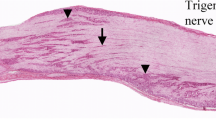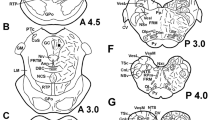Summary
Frequency and size of guinea-pig trigeminal neurones immunoreactive with antisera to α-neo-endorphin(α-neo-END), dynorphin A-(DYN), vasoactive intestinal polypeptide-(VIP), somatostatin-(SOM), and substance P-(SP) are reported. Co-localisation of the various peptides to the same ganglion cells was investigated immunocytochemically in consecutive 7-μm thick paraffin sections. According to their size, all peptide-immunoreactive neurones belong to the class of “small” ganglion cells. Within this cell group, SP-immunoreactive neurones appear to be the largest, followed by SOM-, VIP-, α-neo-END- and DYN-immunoreactive ganglion cells. The observed differences in size are statistically significant with the exception of that between α-neo-END and DYN. This finding correlates well with the observed co-occurrence of the two immunoreactive peptides. All α-neo-END-immunoreactive perikarya are also reactive to VIP antisera. These neurones are significantly smaller than those containing VIP-immunoreactivity exclusively. Ganglion cells displaying co-existence of α-neoEND- and SP-immunoreactivity or VIP- and SP-immunoreactivity are found too infrequently to allow morphometric analysis. Some non-immunoreactive ganglion cells are shown to be approached by dense baskets of VIP-, α-neo-END- or SP-immunoreactive varicose fibres, indicating the presence of intraganglionic modulation sites. The combination of immunohistochemistry and morphometry presented in this study allows the differentiation of diverse populations of primary afferent neurones exhibiting peptide immunoreactivity, most likely reflecting their involvement in different central and peripheral reflex arcs and sensory modalities.
Similar content being viewed by others
References
Arvidsson B, Kristensson K, Olsson Y (1973) Vascular permeability to fluorescent protein tracer in trigeminal nerve and Gasserian ganglion. Acta Neuropathol (Berl) 26:199–205
Brimijoin S, Lundberg JM, Brodin E, Hökfelt T, Nilsson G (1980) Axonal transport of substance P in the vagus and sciatic nerves of the guinea pig. Brain Res 191: 443–457
Chan-Palay V, Palay SL (1977) Ultrastructural identification of substance P cells and their processes in rat sensory ganglia and their terminals in the spinal cord by immunocytochemistry. Proc Natl Acad Sci USA 74:4050–4054
Colombo M, Heym C, Lang R (1986) Immunhistochemie von Opioiden in Paraganglien des Meerschweinchens. Anat Anz (in press)
Costa M, Furness JB, Cuello AC (1985) Separate populations of opioid containing neurons in the guinea-pig intestine. Neuropeptides 5:445–448
Cuello AC, Del Fiacco M, Paxinos G (1978) The central and peripheral ends of the substance P-containing sensory neurones in the rat trigeminal system. Brain Res 152:499–509
Dalsgaard CJ, Vincent SR, Hökfelt T, Lundberg JM, Dahlström A, Schultzberg M, Dockray GJ, Cuello AC (1982) Coexistence of chole cystokinin- and substance P-like peptides in neurones of the dorsal root ganglia of the rat. Neurosci Lett 33:159–163
Dogiel AS (1896) Der Bau der Spinalganglien bei den Säugetieren. Anat Anz 12:140–152
Fink BR, Byers M, Middaugh (1973) Dynamics of colchicine effects on rapid axonal transport and axonal morphology. Brain Res 56:299–311
Forssmann WG, Pickel V, Reinecke M, Hock D, Metz J (1981) Immunohistochemistry and immunocytochemistry of nervous tissue. In: Heym C, Forssmann WG (eds) Techniques in neuroanatomical research. Springer, Berlin Heidelberg New York, pp 171–206
Froesch D (1973) A simple method to estimate the true diameter of synaptic vesicles. J Microsc 98:85–89
Gamse R, Holzer P, Lembeck F (1980) Decrease of substance P in primary afferent neurons and impairment of neurogenic plasma extravasation by capsaicin. Br J Pharmacol 68:207–213
Gillis RA, Helke CJ, Hamilton BL, Norman WP, Jacobowitz DM (1980) Evidence that substance P is a neurotransmitter of baroand chemoreceptor afferents in nucleus tractus solitarius. Brain Res 181:476–481
Gorenstein C, Bundman MC, Lew PJ, Olds JL, Ribak CE (1985) Dendritic transport. I. Colchicine stimulates the transport of lysosomal enzymes from cell bodies to dendrites. J Neurochem 5:2009–2017
Haeusler G, Osterwalder R (1980) Evidence suggesting a transmitter or neuromodulatory role for substance P at the first synapse of the baroreceptor reflex. Naunyn-Schmiedebergs Arch Pharmacol 314:111–121
Helke CJ, O'Donohue TL, Jacobowitz DM (1980) Substance P as a baro- and chemoreceptor afferent neurotransmitter: immunocytochemical and neurochemical evidence in the rat. Peptides 1:1–9
Heym C, Lang R (1985) Transmitters in sympathetic postganglionic neurons. In: Panula P, Päivärinta H, Soinila S (eds) Neurohistochemistry today. Alan R Liss, New York, pp 123–157
Hökfelt T, Kellerth JO, Nilsson G, Pernow B (1975) Experimental immunohistochemical studies on the localization and distribution of substance P in cat primary sensory neurons. Brain Res 100:235–252
Hökfelt T, Elde R, Johansson O, Luft R, Nilsson G, Arimura A (1976) Immunohistochemical evidence for separate populations of somatostatin-containing and substance P-containing primary afferent neurons. Neuroscience 1:131–136
Hökfelt T, Johansson O, Kellerth JO, Ljungdahl A, Nilsson G, Nygards A, Pernow B (1977a) Immunohistochemical distribution of substance P. In: von Euler US, Pernow B (eds) Substance P. Raven Press, New York, pp 117–145
Hökfelt T, Ljungdahl A, Terenius L, Elde R, Nilsson G (1977b) Immunohistochemical analysis of peptide pathways possibly related to pain and analgesia: enkephalin and substance P. Proc Natl Acad Sci USA 74:3081–3085
Horikawa S, Takai T, Toyosato M, Takahashi H, Noda M, Kakidani H, Kubo T, Hirose T, Inayama S, Hayashida H, Miyata T, Numa S (1983) Isolation and structural organization of the human prepro enkephalin B gene. Nature 306:611–614
Jancso G, Hökfelt T, Lundberg JM, Kiraly E, Halasz N, Nilsson G, Terenius L, Rehfeld J, Steinbusch H, Verhofstad A, Elde R, Said S, Brown M (1981) Immunohistochemical studies on the effect of capsaicin on spinal and medullary peptide and monoamine neurons using antisera to substance P, gastrin/CCK, somatostatin, VIP, enkephalin, neurotensin and 5-hydroxytryptamine. J Neurocytol 10:963–980
Johansson O (1978) Localization of somatostatin-like immunoreactivity in the Golgi apparatus of central and peripheral neurons. Histochemistry 58:167–176
Kakidani H, Furutani Y, Takahashi H, Noda M, Morimoto Y, Hirose T, Asai M, Inayama S, Nakanishi S, Numa S (1982) Cloning and sequence analysis of cDNA for porcine β-neoendorphin/dynorphin precursor. Nature (London) 298:245–249
Katz DM, Karten HJ (1980) Substance P in the vagal sensory ganglia: localization in cell bodies and pericellular arborizations. J Comp Neurol 193:549–564
Lang RE, Hermann K, Dietz R, Gaida W, Ganten D, Kraft K, Unger T (1983) Evidence for the presence of enkephalins in the heart. Life Sci 32:399–406
Lee Y, Kawai Y, Shiosaka S, Takami K, Kijama H, Hillyard CJ, Girgis S, MacIntyre I, Emson PC, Tohyama M (1985) Coexistence of calcitonin gene-related peptide and substance P-like peptides in single cells of the trigeminal ganglion of the rat: immunohistochemical analysis. Brain Res 330:194–196
Lehtosalo JI, Uusitalo H, Stjernschantz J, Palkama A (1984) Substance P-like immunoreactivity in the trigeminal ganglion. A fluorescence, light and electron microscope study. Histochemistry 80:421–427
Lembeck F (1953) Zur Frage der zentralen Übertragung afferenter Impulse. III. Mitteilung. Das Vorkommen und die Bedeutung der Substanz P in den dorsalen Wurzeln des Rückenmarks. Naunyn Schmiedebergs Arch Pharmacol 219:197–213
Lembeck F, Holzer P (1979) Substance P as the neurogenic mediator of antidromic vasodilatation and neurogenic plasma extravasation. Naunyn Schmiedebergs Arch Pharmacol 310:175–183
Lembeck F, Donnerer J, Bartho L (1982) Inhibition of neurogenic vasodilatation and plasma extravasation by substance P antagonists, somatostatin and (D-met2, pro5) enkephalinamide. Eur J Pharmacol 85:171–176
Lukas Z, Cech S, Burianed P (1970) Cholinesterase and biogenic monoamines in ganglion semilunare (Gasseri) Histochemie 22:163–168
Lundberg JM, Hökfelt T, Nilsson G, Terenius L, Rehfeld J, Elde R, Said S (1978) Peptide neurons in the vagus, splanchnic and sciatic nerves. Acta Physiol Scand 104:499–501
Maysinger D, Höllt V, Seizinger BR, Mehraein P, Pasi A, Herz A (1982) Parallel distribution of immunoreactive α-neo-endorphin and dynorphin in rat and human tissue. Neuropeptides 2:211–225
Nagy JI, Daddona PE (1985) Anatomical and cytochemical relationships of adenosine deaminase-containing primary afferent neurons in the rat. Neuroscience 15:799–813
Owman C, Santini M (1966) Adrenergic nerves in spinal ganglia of the cat. Acta Physiol Scand 68:127–128
Payan DG, Brewster DR, Goezl E (1983) Specific stimulation of human T lymphocytes by substance P. J Immunol 131:1613–1615
Price J (1985) An immunohistochemical and quantitative estimation of dorsal root ganglion neuronal subpopulations. J Neurosci 5:2051–2059
Ruff MR, Wahl SM, Mergenhagen S, Pert CB (1985) Opiate receptor-mediated chemotoxis of human monocytes. Neuropeptides 5:363–366
Santini M (1966) Adrenergic fibres in the feline Gasserian ganglion. Life Sci 5:283–287
Sharp BM, Keane WF, Suh HJ, Gekker G, Tsukayama D, Peterson PK (1985) Opioid peptides rapidly stimulate superoxide production by human polymorphonuclear leukocytes and macrophages. Endocrinology 177:793–795
Skofitsch G, Zamir N, Helke CJ, Savitt JM, Jacobowitz DM (1985) Corticotropin releasing factor-like immunoreactivity in sensory ganglion and capsaicin sensitive neurons of the rat central nervous system: colocalization with other neuropeptides. Peptides 6:307–318
Smith TW, Buchan P (1984) Peripheral opioid receptors located on the rat saphenous nerve. Neuropeptides 5:217–220
Solloway MR, Stjernschantz J, Sears M (1981) The miotic effect of substance P on the isolated rabbit iris. Invest Ophthalmol Vis Sci 20:47–52
Sternberger LA, Hardy PH, Curculis JJ, Meyer HG (1970) The unlabelled antibody enzyme method of immunohistochemistry. J Histochem Cytochem 18:315–333
Stjernschantz J, Sears M, Stjernschantz L (1981) Intraocular effects of substance P in the rabbit. Invest Ophthalmol Vis Sci 20:53–60
Sweetnam PM, Neale JH, Barker JL, Goldstein A (1982) Localization of immunoreactive dynorphin in neurons cultured from spinal cord and dorsal root ganglia. Proc Natl Acad Sci USA 79:6742–6746
Weber E, Roth KA, Barchas JD (1982) Immunohistochemical distribution of α-neo-endorphin/dynorphin neuronal systems in rat brain: evidence for colocalization. Proc Natl Acad Sci USA 79: 3062–3066
Weihe E, Hartschuh W, Weber E (1985) Prodynorphin opioid peptides in small somatosensory primary afferents of guinea pig. Neurosci Lett 58:347–352
Wolf GK (1980) Klinische Forschung mittels verteilungsunabhängiger Methoden. Springer, Berlin Heidelberg New York
Xiang JZ, Archelos J, Lang RE (1984) Enkephalins in the heart. Clin Exp [Theory and Practice] A6/10 + 11:1883–1888
Zamir N, Palkovitz M, Weber E, Mezey E, Brownstein MJ (1984) A dynorphinergic pathway of Leu-enkephalin production in substantia nigra. Nature (London) 307:643–645
Author information
Authors and Affiliations
Rights and permissions
About this article
Cite this article
Kummer, W., Heym, C. Correlation of neuronal size and peptide immunoreactivity in the guinea-pig trigeminal ganglion. Cell Tissue Res. 245, 657–665 (1986). https://doi.org/10.1007/BF00218569
Accepted:
Issue Date:
DOI: https://doi.org/10.1007/BF00218569




